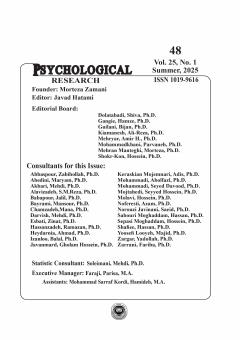رابطه رويکردهاي طراحي شغل (رویکردهای مکانیکی و انگیزشی) با نگرشهای شغلی در مجموعهاي از مشاغل
الموضوعات : psychology
هاجر براتی
1
,
حمیدرضا عریضی
2
![]()
1 - دانشگاه اصفهان
2 - دانشگاه اصفهان
الکلمات المفتاحية: کلیدواژهها: تعهد سازماني, درگیری در کار, رضايت شغلي, رويکرد انگيزشي طراحی شغل, رويکرد مکانيکي طراحی شغل,
ملخص المقالة :
چکیده: مطالعات اخير اهميت تفاوت بين انواع مختلف طراحي کار برمبناي انگيزش و نگرشهای شغلی را مشخص کردهاند. به همین دلیل این پژوهش با هدف بررسی رابطه رويکردهاي طراحي شغل (رویکردهای مکانیکی و انگیزشی) با نگرشهای شغلی (رضايت شغلي، درگیری در کار و تعهد سازماني) در مجموعهاي از مشاغل انجام شد. شرکتکنندگان در تحقيق حاضر متصديان 125 شغل عملیاتی و کارشناسی (40 شغل از مجموع مشاغل شرکت اتومبيلسازي سايپا، 40 شغل از مجموع مشاغل صنايع فولاد، 20 شغل از صنايع نظامي، 25 شغل از مجموع مشاغل شرکت ملي گاز و نفت) بودند که هر شغل توسط سه مشاهدهگر آموزش ديده مورد مشاهده قرار گرفت. ابزار مورد استفاده مشاهدهگران، پرسشنامه طراحي شغل چند روشي (MJDQ) بود که توسط کمپیون و تایر (1985) تدوین گردیده است. شاخص توصيف شغل (JDI)، مقياس تعهد سازماني و مقیاس درگیری در کار نیز توسط شرکتکنندگان پاسخ داده شد. يافتههاي تحقيق نشان دادند که رويکرد انگيزشي با متغيرهاي ملاک (رضايت شغلي، درگیری در کار و تعهد سازماني) همبستگي مثبت دارد، رويکرد مکانيکي با متغيرهاي ملاک همبستگي منفي دارد و رويکرد انگيزشي همبستگي منفي با رويکرد مکانيکي دارد. هرچند رابطه مجموعه رويكردهاي طراحي شغل با نگرشهاي شغلي معنیدار است اما جهتگيري آن براي رويكرد مكانيكي منفي و برای رویکرد انگیزشی مثبت است و نشان ميدهد كه دو رويكرد داراي جهتگيري متفاوتاند. براين مبنا استفاده از مزاياي طراحي مكانيكي بايد با طراحي انگيزشي درهم تنيده شود تا رضایت، تعهد و درگیری شغلی كاركنان كاهش نيايد.


